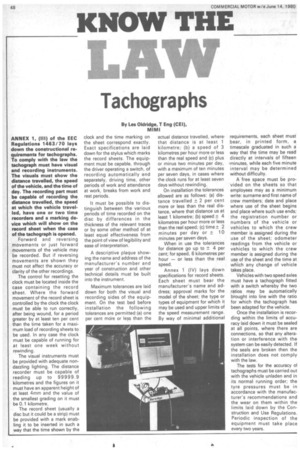Tachographs
Page 50

If you've noticed an error in this article please click here to report it so we can fix it.
By Les Oldridge, T Eng (CE I), MIMI ANNEX 1, (III) of the EEC Regulations 1463/70 lays down the constructional requirements for tachographs. To comply with the law the tachograph must have visual and recording instruments. The visuals must show the distance travelled, the speed of the vehicle, and the time of day. The recording part must be capable of recording the distance travelled, the speed at which the vehicle travelled, have one or two time recorders and a marking device which will show on the record sheet when the case of the tachograph is opened.
Forward and reversing movements or just forward movements of the vehicle may be recorded. But if reversing movements are shown they must not affect the accuracy or clarity of the other recordings.
The control for resetting the clock must be located inside the case containing the record sheet. Where the forward movement of the record sheet is controlled by the clock the clock must be able to run correctly, after being wound, for a period greater by at least ten per cent than the time taken for a maximum load of recording sheets to be used. In any case the clock must be capable of running for at least one week without rewinding.
The visual instruments must be provided with adequate nondazzling lighting. The distance recorder must be capable of reading up to 99999.9 kilometres and the figures on it must have an apparent height of at least 4mm and the value of the smallest grading on it must be 0.1 kilometre.
The record sheet (usually a disc but it could be a strip) must be provided with a mark enabling it to be inserted in such a way that the time shown by the clock and the time marking on the sheet correspond exactly. Exact specifications are laid down for the stylus which marks the record sheets. The equipment must be capable, through the driver operating a switch, of recording automatically and separately, driving time, other periods of work and attendance at work, breaks from work and rest periods.
It must be possible to distinguish between the various periods of time recorded on the disc by differences in the thickness of the relevant traces or by some other method of at least equal effectiveness from the point of view of legibility and ease of interpretation.
A descriptive plaque showing the name and address of the manufacturer's number and year of construction and other technical details must be built into the instrument.
Maximum tolerances are laid down for both the visual and recording sides of the equipment. On the test bed before installation the following tolerances are permitted:(a) one per cent mdre or less than the actual distance travelled, where that distance is at least 1 kilometre; (b) a speed of 3 kilometres per hour more or less than the real speed and (c) plus or minus two minutes per day, with a maximum of ten minutes per seven days, in cases where the clock runs for at least seven days without rewinding.
On installation the tolerances allowed are as follows: (a) distance travelled ±2 per cent more or less than the real distance, where that distance us at least 1 kilometre; (b) speed ± 4 kilometres per hour more or less than the real speed; (c) time ± 2 minutes per day or ± 10 minutes per seven days.
When in use the tolerances for distance go up to -± 4 per cent; for speed, 6 kilometres per hour — or less than the real speed.
Annex 1 (IV) lays down specifications for record sheets. Each sheet must bear the manufacturer's name and address; approval marks for the model of the sheet; the type or types of equipment for which it may be used and upper limits of the speed measurement range. By way of minimal additional requirements, each sheet must bear, in printed form, a timescale graduated in such a way that the time may be read directly at intervals of fifteen 'minutes, while each five minute interval may be determined without difficulty.
A free space must be provided on the sheets so that employees may as a minimum write: surname and first name of crew members; date and place where use of the sheet begins and place where such use ends; the registration number or numbers of the vehicle or vehicles to which the crew member is assigned during the use of the sheet; odometer readings from the vehicle or vehicles to which the crew member is assigned during the use of the sheet and the time at which any change of vehicle takes place.
Vehicles with two speed axles must have a tachograph fitted with a switch whereby the two ratios may be automatically brought into line with the ratio for which the tachograph has been adapted for the vehicle.
Once the installation is recording within the limits of accuracy laid down it must be sealed at all points, where there are connections, so that any alteration or interference with the system can be easily detected. If the seals are broken then the installation does not comply with the law.
The tests for the accuracy ol tachographs must be carried out with the vehicle unladen and in its normal running order; the tyre pressures must be in accordance with the manufacturer's recommendations and the wear on them within the limits laid down by the Construction and Use Regulations. Periodic inspection of the equipment must take place every two years.
















































































































